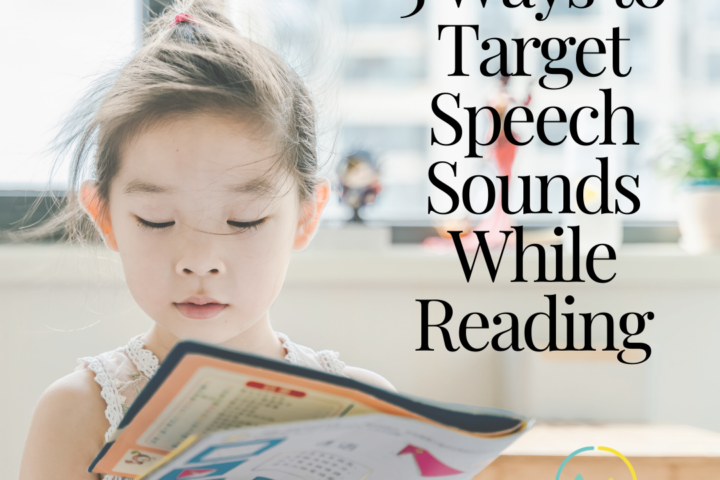I am living for my walks these days. We’re currently on a two-a-day schedule, or however many our dog demands. It’s good to get outside and enjoy the weather, especially here in Michigan! I’m not alone. I see families on walks even where I live (in the middle of nowhere). Facebook and Instagram are plastered with pictures of parents taking their kiddos on walks. My best friend, Courtney, even dresses up her daughter in weather-appropriate gear and takes her out in the rain! Since we’re all out walking, why not use it as an opportunity to build some language skills? If you’re feeling up for it, there are lots of ways to target language while hoofing it. Try giving your walks a language-boost by focusing on a few skills.

Following Directions
Walks provide any number of opportunities for you to practice directions with your kids. Task them with finding things on the walk. Say something like, “Find something hard and then something green,” and let them loose. You may need to increase or decrease the difficulty depending on the age and ability level of your kiddo. To simplify, use one step directions (i.e. “Find something green.”), use concrete nouns (“Find a leaf.”), or join them in on the search and complete the tasks side-by-side. To increase the difficulty, add multiple steps – add objects to find, add in movement directions (“Find something hard, jump up and spin, and then find something green”), or other random tasks (“Find something hard and then sing ‘Let it Go.”). Be creative and goofy!
Vocabulary
Vocabulary surrounds us 100% of the time. New vocabulary, though, can be found on walks. How you address vocabulary will depend on your child’s age and skill level. For children who are learning new vocabulary, point out new or unusual objects as you walk by. Plants, bugs, leaves, objects in peoples’ lawns, cars, and other gadgets can all be singled out and named. If your child points to an object, label it! “Oh, I see that pink flower too!”
For older children with a bigger vocabulary, start focusing on synonyms and antonyms. If your child says, “That’s a big house,” challenge them to think of other words for “house.” If they can’t think of any, model the words yourself (abode!). You can do the same for descriptors like “big.” See what they come up with.
I’m here for all of the cool artwork that is popping up in windows and driveways and sidewalks these days. Take time to stop and discuss these if they exist in your neighborhood. Point them out, label them, and describe them!
Descriptions
I touched on descriptions a bit in the vocabulary section, but why not talk about it again? Walks are the perfect opportunity for “I Spy.” This game forces kiddos to use their description skills, both expressively and receptively, to play the game well. For younger kiddos, you might have to do quite a bit of modeling to get them in the groove. Start with very obvious objects and very obvious descriptions. After a few models, let them try on their own. With older kiddos, challenge them to come up with 2-3 descriptions of the object without being too obvious. Use your judgement, and have fun!
Verbs
Do you remember the video of my lovely little friend Avery working on her verbs? While obstacle courses like this are amazing, you can do a lot of the same work on a walk. Something as simple as “stop” and “go” are great to address! If you want to get creative, ask your kiddo to “skip!” or “jump like a frog” at random intervals. If you’re a competitive family, feel free to put a race-twist on it. Go from telephone pole to telephone pole with a different objective – spin, jump, dance, run, whatever! See who can finish the fastest.
Letter/Sound Knowledge and Problem Solving
When I was a child, we lived across the street from a cemetery. OK CREEPY, YEAH OK, but, listen. It was a super safe place to walk (obviously), and that’s what we did. My dad and I used to play this game that went like this, “My name is ______. I’m married to ________. We live in ________ and we sell ________.” All of the fill-in-the-blanks had to be the same letter, though. So, for ‘a’, it would be something like, “My name is Alice. I’m married to Adam. We live in Anapolis and we sell apples.” We’d work our way through the alphabet while we took a stroll. While you may need to update to a more modern wording, this activity is a fun way to get kids thinking about letters, sounds, and vocabulary all at the same time.
What are some things you’re doing on your walks to make them language-rich? Leave a comment and let us know!




Great practical (and fun) tips for parents, grandparents, and other caregivers! If we’re out for a nice walk, why not inject it with discourse, conversation, interaction, exchange, verbiage, and related interlocutory activity?